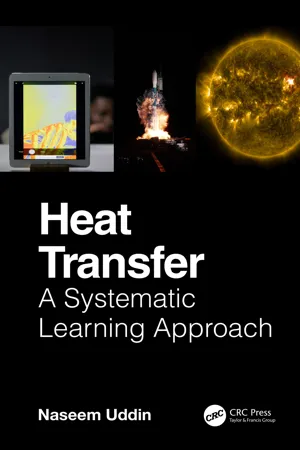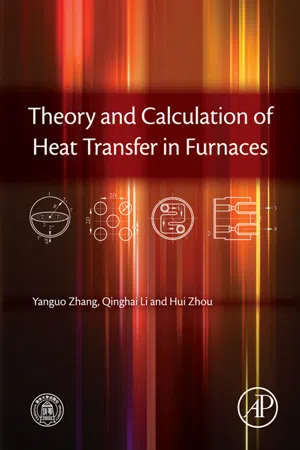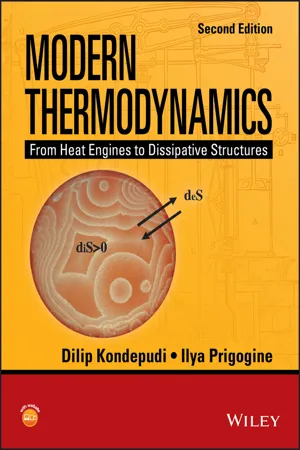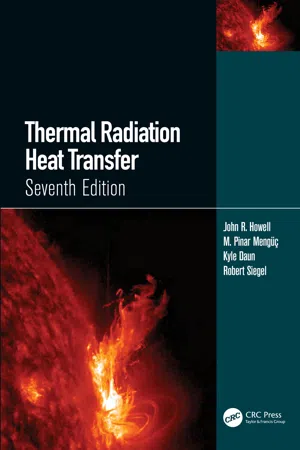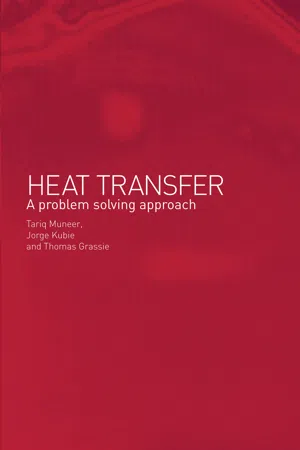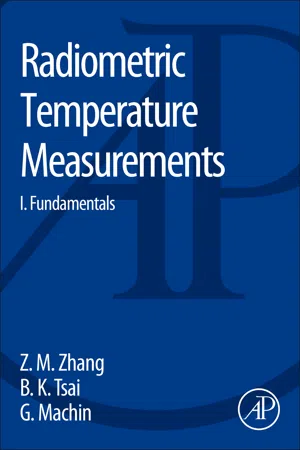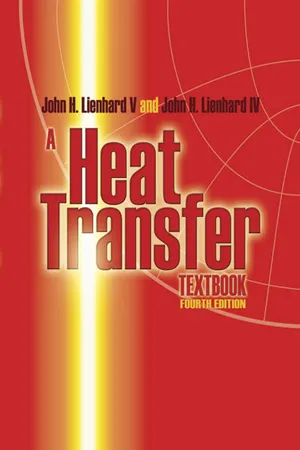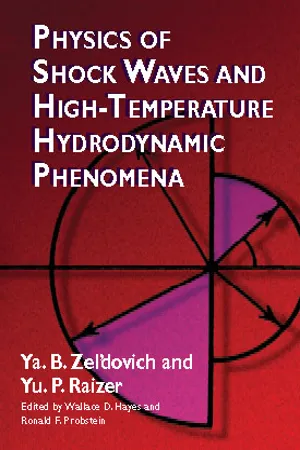Physics
Thermal Radiation
Thermal radiation refers to the emission of electromagnetic waves from the surface of an object due to its temperature. This type of radiation does not require a medium to propagate and can transfer heat energy from one object to another through electromagnetic waves. It plays a crucial role in the transfer of heat energy in various natural and industrial processes.
Written by Perlego with AI-assistance
Related key terms
Related key terms
1 of 4
Related key terms
1 of 3
10 Key excerpts on "Thermal Radiation"
- eBook - ePub
Heat Transfer
A Systematic Learning Approach
- Naseem Uddin(Author)
- 2024(Publication Date)
- CRC Press(Publisher)
13 Fundamentals of Thermal RadiationDOI: 10.1201/9781003428404-13Radiation is a surface phenomenon in the case of solid and liquid bodies, and it happens volumetrically in gases comprising of molecules having more than two atoms. Radiations occur due to electromagnetic waves, and it is the most dominant mode at high temperatures. Radiation is the only mode of heat transfer outside the earth's atmosphere and thus plays important role in space technology designs. After finishing this chapter, one will be able to:- ■ State Stefan-Boltzmann law, Planck's law, Wien's displacement law, and Kirchhoff law.
- ■ Understand the emissivity, absorptivity, reflectivity, and transmissivity of the surfaces.
- ■ Compute black and gray body emissions.
- ■ Understand the terminology related to extraterrestrial radiation.
Heat transfer between solid or liquid surfaces, and gases because of electromagnetic waves is Thermal Radiation. All matter forms constantly emit Thermal Radiation, which is mainly due to the vibrational, rotational motions of atoms and molecules of a substance.The electromagnetic waves are classified in Table 13.1Table 13.1Classification of Electromagnetic WavesWavelengthType10-14 m - 10-12 mCosmic radiation 10-12 m - 10-10 mGamma radiation 10-10 m - 10-9 mX-rays 10 nm - 400 nm Ultraviolet radiation 380 nm - 760 nm Visible radiation 0.1 μm - 100 μmThermal Radiation In order to explain the behaviour of electromagnetic Thermal Radiation, scientist have created the concept of a blackbody. The blackbody is a ideal - Yanguo Zhang, Qinghai Li, Hui Zhou(Authors)
- 2016(Publication Date)
- Academic Press(Publisher)
Thermal energy is the energy possessed by a substance due to the random and irregular motion of its atoms or molecules. Thermal Radiation is the transformation of energy from thermal energy to radiant energy by emission of rays. The wavelength range encompassed by Thermal Radiation is approximately from 0.1 to 1000 μm, which can be divided into three subranges: the infrared from 0.7 to 1000 μm, the visible from 0.4 to 0.7 μm, and the near ultraviolet from 0.1 to 0.4 μm. Thermal Radiation is a form of heat transfer between objects, characterized by the exchange of energy by emitting and absorbing thermal rays.Consider, for example, two concentric spherical shells with different initial temperatures (t 1 < t 2 ) separated by a vacuum, as shown in Fig. 1.2 . The temperature of sphere shell 2 increases as a result of heat exchange by Thermal Radiation between the two shells, since there is no heat conduction or heat convection between them.Figure 1.2 Radiation heat transfer between concentric sphere shells.This chapter will briefly outline the essential characteristics of Thermal Radiation, and the fundamental parameters that describe Thermal Radiation properties. The description of the basic laws of Thermal Radiation and the general methods used in Thermal Radiation transfer calculation are emphasized, as these are the theoretical foundation for solving heat radiation transfer problems and conducting related engineering calculations.1.1. Thermal Radiation theory—Planck’s law [1 ,2 ,23 ,24 ]
At the end of the 19th century, classical physics had encountered two major roadblocks: the problem of relative motion between ether and measurable objects, and the spectrum law of blackbody radiation, that is, the failure of the energy equipartition law. The solution to the first problem led to relativity theory, and the second problem was solved after the establishment of quantum theory. Quantum theory also solved the problems of blackbody radiation, photoelectric effect, and Compton scattering.- eBook - ePub
Light and Optics
Principles and Practices
- Abdul Al-Azzawi(Author)
- 2018(Publication Date)
- CRC Press(Publisher)
3 Thermal Radiation 3.1 INTRODUCTIONIn the absence of heat, life cannot be sustained in the universe. Thermal Radiation serves as an essential ingredient for the formation (and existence) of life in the cosmos Thermal Radiation represents a finite region of the electromagnetic spectrum.Thermal imaging cameras permit the ability to observe the flow of thermal energy between two bodies. Thermal images from space have illustrated the flow of energy within the universe.Thermal Radiation is the transfer of energy by electromagnetic waves, which have a range of wavelengths. One example of Thermal Radiation heat transfer is that of energy transfer between the Sun and the Earth. The emitted radiant heat is the net flow of heat from a higher temperature material to a lower temperature material. The high temperature material emits energy and the low temperature material absorbs this energy. Many developing countries have exploited this principle as a means of renewable solar energy. This transfer (or flow) is dependent on a material’s ability to transmit, reflect or absorb thermal energy. In this chapter, the nature of Thermal Radiation, its characteristics, and properties are presented.The experiment included in this chapter requires an understanding of the concepts of solar radiation intensity levels and measurements when using a solar radiation meter. The solar radiation variation during the day will be measured and studied. Also the sun positions during the day hours will be studied.3.2 Thermal RadiationThermal Radiation is the electromagnetic radiation emitted by a body as a result of its temperature. For a net Thermal Radiation interchange of energy between two bodies to occur, there must be a temperature difference. The rate at which the Thermal Radiation interchange occurs is proportional to the difference of the fourth powers of their absolute temperatures. For a better understanding of Thermal Radiation, it will be necessary to study several different disciplines: - eBook - ePub
Modern Thermodynamics
From Heat Engines to Dissipative Structures
- Dilip Kondepudi, Ilya Prigogine(Authors)
- 2014(Publication Date)
- Wiley(Publisher)
11 Thermodynamics of RadiationIntroduction
Electromagnetic radiation, which interacts with matter, also reaches the state of thermal equilibrium with a definite temperature. This state of electromagnetic radiation is called Thermal Radiation, also called heat radiation in earlier literature. In fact, today we know that our universe is filled with Thermal Radiation at a temperature of about 2.73 K.It has long been observed that heat transfer can take place from one body to another in the form of radiation with no material contact between the two bodies. This form of heat was called ‘heat radiation’. When it was discovered that motion of charges produced electromagnetic radiation, the idea that heat radiation was a form of electromagnetic radiation was taken up, especially in the works of Gustav Kirchhoff (1824–1887), Ludwig Boltzmann (1844–1906), Joseph Stefan (1835–1893) and Wilhelm Wien (1864–1928), and its thermodynamic consequences were investigated [1].11.1 Energy Density and Intensity of Thermal Radiation
We begin by defining basic quantities required to study the properties of Thermal Radiation (here we follow the classic work of Planck on Thermal Radiation [1]). Radiation is associated with energy density u, which is the energy per unit volume, and specific intensity or radiance, I, which is defined as follows (Figure 11.1a ): the energy incident per unit time on a small area, dσ, due to radiation form a solid angle dΩ (=sin θ dθ dϕ), which makes an angle θ with the surface normal and equals I cos θ dΩ dσ. The total amount of radiation incident on one side of the area dσ (Figure 11.1b ) is equal to ∫π/2 θ = 0 ∫ϕ = 0 2π I cos θ dΩ = ∫π/2 θ = 0 ∫ϕ = 0 2π I cos θsin θ dθ dϕ = πI. The quantity πI is called the radiation intensity or irradiance or radiant flux density. Electromagnetic radiation has two independent states of polarization. The above quantities can be defined for each independent state of polarization. For unpolarized light, as in the case of Thermal Radiation, the total intensity is the sum of the intensities of the two independent states of polarization. A similar definition can be used for radiation emitted from a small surface area dσ, in which case πI is the per unit area of the surface, called radiation intensity or irradiance - eBook - ePub
- John R. Howell, M. Pinar Mengüc, Kyle Daun, Robert Siegel(Authors)
- 2020(Publication Date)
- CRC Press(Publisher)
The emission of Thermal Radiation arises from random fluctuations in the quantized internal energy states of the emitting matter. Temperature is a measure of the internal energy level of matter, and the nature of the fluctuations can be related to an object’s temperature. Once the energy is radiated, it propagates as an electromagnetic (EM) wave. If the waves encounter matter, they may partially lose their energy and increase the internal energy of the receiving matter. This is called absorption. The amount of emitted and absorbed radiation are functions of the physical and chemical properties of the material as well as its internal energy level, as quantified by its temperature. An EM wave can also undergo scattering as it propagates through a heterogeneous medium, e.g., a porous ceramic, a layer of freshly fallen snow or even the molecules in a gas. As waves encounter these scattering centers, they are reflected, refracted, or diffracted, or any combination of these phenomena, which redirects the wave without increasing the internal energy of the scatterer. The propagation and scattering of EM waves, including all effects of reflection, refraction, transmission, polarization and coherence, are governed by the Maxwell equations, as we discuss in Chapters 8, 10, and 16. Since all matter emits and absorbs radiation under all conditions, there is always radiative transfer of energy, even within an isothermal system. If two objects are at different temperatures, there will be net radiation energy transfer between them, even if there is no matter between the objects. An obvious example is radiation emitted by the sun, which travels through the vacuum of space and is partially absorbed and scattered upon entering the earth’s atmosphere. A significant part of this radiation reaches the earth’s surface, where again, some is absorbed and some is reflected (Figure 1.1) - eBook - ePub
Heat Transfer
A Problem Solving Approach
- Kubie Jorge, Tariq Muneer, Grassie Thomas(Authors)
- 2012(Publication Date)
- Routledge(Publisher)
9 Thermal Radiation
9.1 Introduction
In contrast to convection and conduction, heat transfer by Thermal Radiation does not require the presence of matter. However, as we shall see in the following sections, its interaction with matter is of great importance in many natural and industrial processes. In introducing radiation , we will first present the fundamental concepts necessary for its understanding.9.1.1 Fundamental concepts
Through the vibration and transition of electrons within atoms, all matter emits radiation. Radiation may be considered as the propagation of either electromagnetic waves , or as photons or quanta . The internal energy, or temperature, of a medium is a measure of the degree of vibration and excitation of the electrons within that medium. For the present case, as T S > T sur , while both the surroundings and the solid emit radiation, the net radiant energy exchange from the solid to the surroundings, q rad, net, will be positive. The solid will therefore cool as it's internal energy decreases until thermal equilibrium is reached.For most solids and liquids, radiation emitted by interior molecules is absorbed by those adjacent, and hence does not reach the medium's surface. Consequently, radiation may be considered to be a surface phenomenon, originating from molecules that are within a distance of approximately 1µm of the surface. As radiation may be considered to have the form of electromagnetic waves, it will therefore have standard wave properties of frequency, f , and wavelength, λ . The relationship between these two properties is as given inwhere c is the speed of light in the medium (in a vacuum c o = 2.988 × 108 m/s).Within the spectrum of electromagnetic radiation, Thermal Radiation is emitted between approximately 0.1 and 1000µm. This includes a portion of the UV range (0.01–0.4µm), and all of the visible and infrared. All surfaces emit radiation. Both the magnitude of the radiation at a specific wavelength, and its spectral distribution, are dependent on both the temperature, and the properties of the emitting surface. Hence, the rate of Thermal Radiation heat - eBook - ePub
- R.A. Edwards(Author)
- 2014(Publication Date)
- Pergamon(Publisher)
CHAPTER 17Thermal Radiation
Publisher Summary
This chapter discusses concept and measurement techniques of Thermal Radiation. Radiation is defined as the mode of transmission of heat in which a hotter body loses heat and a colder body receives heat by a means of a process occurring in some intervening medium that thereby does not itself become hot. All electromagnetic waves of whatever wavelength travel with the same speed in a vacuum. The longest electromagnetic waves are produced by alternating devices, such as electrical generators. Electromagnetic waves possess the general properties of wave motion, that is, reflection, refraction, diffraction, interference, etc. A radio micrometer is a quick-acting, sensitive instrument designed by Boys, which is free from zero error and which combines thermocouple and galvanometer. A bolometer is an instrument originally designed by Langley. Its action depends on the variation of resistance with temperature of electrical conductors, notably platinum. The experiments show that the best radiators are dull black surfaces and the worst are bright polished surfaces.17.1 Electromagnetic Radiation
Radiation, as applied to heat transmission, has been defined as the mode of transmission of heat in which a hotter body loses heat and a colder body receives heat by means of a process occurring in some intervening medium which does not itself thereby become hot. This definition of radiant heat is a very correct one and certainly distinguishes it from conduction and convection but leaves one to ask the obvious question: “What is the nature of the process which occurs in the intervening medium?” Without some sort of answer to this question the definition does not take us very far. In Thermal Radiation the passage of “heat” does not heat up the space through which it passes and since, in fact, radiant heat may pass through a vacuum, it is difficult to see how the space can - eBook - ePub
Radiometric Temperature Measurements
I. Fundamentals
- (Author)
- 2009(Publication Date)
- Academic Press(Publisher)
m .More details on the mechanism of radiation emission, as well as how radiation propagates inside a medium and how it interacts with materials, will be presented in the remainder of this chapter. Section 2 discusses the thermodynamic theory of blackbody radiation. Section 3 defines radiative properties of materials and the relationship between different properties. Section 4 elaborates on the electromagnetic-wave theory and how to apply the macroscopic Maxwell equations to describe wave propagation inside a medium as well as wave reflection and refraction at the interface between different media. Section 5 addresses models of the frequency-dependent dielectric functions of various solid materials in the optical frequency region. Section 6 presents methods to obtain radiative properties of layered structures. A brief summary is given in Section 7 .2. Thermodynamics of Blackbody Radiation
2.1. Radiance, heat flux, irradiance, and exitance
The spectral radiance is defined as the radiant power dq from a pencil cone, as shown in Figure 3 , from a surface area dA in the direction (defined by the zenith angle θ and the azimuthal angle φ), per unit wavelength interval, per unit solid angle, and per unit area projected onto the direction . Hence the spectral radiance iswhere dΩ is the element solid angle, and the unit of Lλ is W/(m2 srμm). Note that q is also called radiant flux, denoted by the symbol Φ in some chapters of this book. Using the spherical polar coordinates shown in Figure 4 , by definition, we have(4) (5) - eBook - ePub
A Heat Transfer Textbook
Fourth Edition
- John H Lienhard, John H Lienhard(Authors)
- 2013(Publication Date)
- Dover Publications(Publisher)
ART IVTHERMAL RADIATION HEAT TRANSFER
Passage contains an image
10. Radiative heat transfer
The sun that shines from Heaven shines but warm,And, lo, I lie between that sun and thee:The heat I have from thence doth little harm,Thine eye darts forth the fire that bumeth me:And were I not immortal, life were doneBetween this heavenly and earthly sun.Venus and Adonis, Wm. Shakespeare, 159310.1 The problem of radiative exchange
Chapter 1 included the elementary mechanisms of heat radiation. Before we proceed, you should reflect upon what you remember about the following key ideas from Chapter 1 :• Electromagnetic wave spectrum• Heat radiation & infrared radiation• Black body• Absorptance, α• Reflectance, ρ• Transmittance, τ• α + ρ + τ = 1• e(T) and eλ(T) for black bodies• The Stefan-Boltzmann law• Wien’s law & Planck’s law• Radiant heat exchange• Configuration factor, F1−2• Emittance,• Transfer factor, 1−2• Radiation shieldingThe additional concept of a radiation heat transfer coefficient was developed in Section 2.3 . We take these concepts for granted in what follows.The heat exchange problemFigure 10.1 shows two arbitrary surfaces radiating energy to one another. The net heat exchange, Qnet , from the hotter surface (1) to the cooler surface (2) depends on the following influences:Figure 10.1 Thermal Radiation between two arbitrary surfaces.• T1 and T2 .• The areas of (1) and (2), A1 and A2 .• The shape, orientation, and spacing of (1) and (2).• The radiative properties of the surfaces.• Additional surfaces in the environment, which may reflect radiation from surface (1) to surface (2)• The medium between (1) and (2) if it absorbs, emits, or “reflects” radiation. (When the medium is air, we can usually neglect these effects.)If surfaces (1) and (2) are black, if they are surrounded by air, and if no heat flows between them by conduction or convection, then only the first three considerations are involved in determining Qnet . We saw some elementary examples of how this could be done in Chapter 1 - Ya. B. Zel’dovich, Yu. P. Raizer, Yu. P. Raizer(Authors)
- 2012(Publication Date)
- Dover Publications(Publisher)
of the order of unity). In other words, photons, emitted from the surface of the body, are born mainly in a layer near the surface with an optical thickness of the order of unity (to be more precise, of two or three). This layer can be called the radiating layer. Photons born in layers farther removed from the surface are almost totally absorbed before reaching the surface. The brightness temperature, as follows from equation (2.52), is therefore equal to some average temperature of the radiating layer.Photons emerging from the surface at frequencies for which the absorption is stronger and the radiation mean free path is shorter, are radiated in the less heated layers closer to the surface. Conversely, frequencies at which the absorption is weaker emerge from the deeper and more heated layers. Thus, if the temperature of the fluid decreases toward the surface (as is usually the case), the brightness temperature for the strongly absorbed frequencies is less than that for the weakly absorbed frequencies. This is represented schematically in Fig. 2.7 by the arrows indicating the “spots” from which the photons of different frequencies may be considered to be emitted. These “spots” are located relative to the surface at distances of the order of the photon mean free paths.The radiation spectrum for a nonuniformly heated body is different from the Planck spectrum; the difference is the more pronounced the stronger is the dependence of the absorption coefficient upon frequency and temperature, and the steeper is the temperature gradient near the surface (at distances of the order of the photon mean free paths). Figure 2.8 is a schematic representation of the radiation spectrum of a body with a temperature decreasing toward the surface and with an absorption coefficient that varies inversely with the frequency, i.e., with the lower frequencies absorbed more strongly than the higher ones. Discrete lines, corresponding to the bound-bound transitions in atoms or ions, have been superimposed on the continuous spectrum. The absorption coefficients of these lines are always very high, much higher than in the continuous spectrum. Hence, the brightness temperature of these lines almost exactly coincides with the temperature close to the surface of the body (the lines are “cut” into the radiation spectrum of the body). For comparison, the dashed curve in Fig. 2.8
Index pages curate the most relevant extracts from our library of academic textbooks. They’ve been created using an in-house natural language model (NLM), each adding context and meaning to key research topics.
Explore more topic indexes
Explore more topic indexes
1 of 6
Explore more topic indexes
1 of 4
